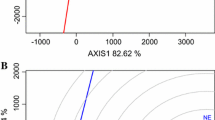Summary
Four selection experiments were sown: single-row plots with single row-spacing (≃20 cm), single-row plots with double row spacing (≃40 cm), three-row plots and six-row plots both with single row-spacing (≃20 cm). Selection entries were mimiced by 16 different varieties or advanced breeding lines, which were also sown in a yield trial. Each experiment was laid out as a 4-times replicated randomized block design. Row length was 2 m. Alley borders and border-rows of multiple-row plots were harvested separately to evaluate the effects of different harvesting procedures on the selection efficiency. Removal of alley borders was found to be disadvantageous, since the gain in precision was more than offset by the loss in sampled area. Wide spacing of single-row plots improved the selection efficiency in comparison with normal spaced single-row plots. In multiple-row plots the selection efficiency was not improved by harvesting only the central rows.
For gross plot yield (= yield of net plot + yield of alley borders) the differences in selection efficiency between the various selection plot-types were explained on the basis of the genetic variance, the environmental variance and the coefficient of genetic correlation with ‘farm’ yield as determined in the yield trial.
Similar content being viewed by others
References
Alessandroni, A. & M. C. Scalfati, 1973. Early-generation selection for grain yield of dwarf and semidwarf progenies of durum wheat crosses. Proc. 4th Intern. Wheat Genetics Symp. Columbia, Miss. pp. 475–482.
Aguilar, M. I. & R. A., Fischer, 1975. Analysis de crecimiento y rendimiento de genotipos de trigo bajo condiciones ambientales optimas de cultivo. Agrociencia (Mexico) 21: 185–198.
Austin, R. B. & R. D., Blackwell, 1980. Edge and neighbour effects in cereal yield trials. J. agric. Sci., Camb. 94: 731–734.
Baker, R. J. & F. G., Kosmolak, 1977. Effects of genotype — environment interaction on bread wheat quality in western Canada. Can. J. Plant Sci. 57: 185–191.
Becker, W. A., 1975. Manual of quantitative genetics. Washington State Univ. Press. Pullman, Washington.
Bos, I., 1981. The relative efficiency of honeycomb selection and other procedures for mass selection in winterrye (Secale cereale L.) 172 p. Doctoral thesis, Agricultural University, Dept. Plant Breeding, Wageningen.
Briggs, K. G. & L. H., Shebeski, 1971. Early generation selection for yield and breadmaking quality of hard red spring wheat (Triticum aestivum L. em Thell). Euphytica 20: 453–463.
DePauw, R. M. & L. H., Shebeski, 1973. An evaluation of early generation yield testing procedure in Triticum aestivum. Can. J. Plant Sci. 53: 465–470.
Donald, C. M. & J., Hamblin, 1976. The biological yield and harvest-index of cereals as agronomic and plant breeding criteria. Adv. Agron. 28: 361–405.
Falconer, D. S., 1960. Introduction to quantitative genetics. Ronald Press Company, New York.
Fischer, R. A., 1979. Are your results confounded by intergenotypic competition? Proc. 5th Int. Wheat Genet. Symp., Febr. 23–28, 1978. New Dehli, India, p. 769–776.
Jain, H. K. & V. P., Kulshrestha, 1976. Dwarfing genes and breeding for yield in bread wheat. Z. Pflanzenzüchtg 76: 102–112.
Kramer, Th., 1979. Enivoronmental and genetic variation for protein content in winter wheat (Triticum destivum L.). Euphytica 28: 209–218.
Seitzer, J. F. & L. E., Evans, 1978. Yield gains in wheat by the pedigree method of selection and two early yield tests. Z. Pflanzenzüchtg 80: 1–10.
Shebeski, L. H., 1967. Wheat and wheatbreeding. Proc. Can. Centennial Wheat Symp. (Ed. K. F., Nielson). Modern Press, Saskatoon. p. 249–272.
Spitters, C. J. T., 1979. Competition and its consequences to selection in barley breeding. Agric. Res. Rep. 893, Wageningen, 268 p.
Syme, J. R., 1970. A high-yielding Mexican semi-dwarf wheat and the relationship of yield to harvest-index and other varietal characteristics. Austr. J. Exp. Agric. Anim. Husb. 10: 350–353.
Ven, A. C. M., van de, 1981. De invloed van standafwijkingen op de opbrengst bij zomertarwe. Internal Research Report, Library Dept. Plantbreeding, pp. 73.
Whan, B. R., A. J., Rathjen & R., Knight, 1981. The relation between wheat lines derived from the F2, F3, F4 and F5 generations for grain yield and harvest index. Euphytica 30: 419–429.
Whan, B. R., R. Knight & A. J. Rathjen, 1982. Response to selection for grain yield and harvest index in the F2, F3 and F4 of two wheat crosses. Euphytica 31, accepted.
Author information
Authors and Affiliations
Rights and permissions
About this article
Cite this article
Kramer, T., Van Ooijen, J.W. & Spitters, C.J.T. Selection for yield in small plots of spring wheat. Euphytica 31, 549–564 (1982). https://doi.org/10.1007/BF00039193
Received:
Issue Date:
DOI: https://doi.org/10.1007/BF00039193




